Creating vegan wax perfumes at home lets you control exactly what goes into your signature scent while avoiding synthetic chemicals and animal-derived ingredients. You'll save money compared to luxury natural perfumes, and you can customize seasonal fragrances that perfectly match your preferences. With simple equipment and plant-based waxes like carnauba or candelilla, you can craft portable, long-lasting perfumes. The growing natural fragrance movement offers endless possibilities for your aromatic journey.
The Rise of Natural Fragrance Making
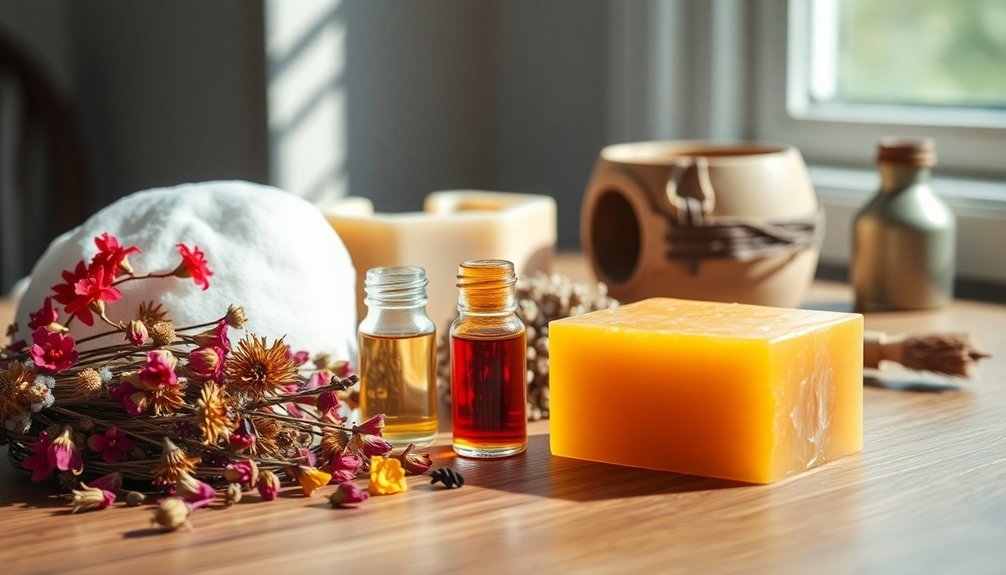
While synthetic fragrances dominated the market for decades, natural fragrance making has experienced a remarkable resurgence in recent years.
You're part of a growing movement, as 75% of consumers now favor sustainable, environmentally friendly fragrances. This shift isn't just a trend – it's reshaping the entire industry.
The natural fragrance revolution isn't just about personal choice – it's a collective shift transforming how we think about sustainable scents.
You'll find the natural fragrance market is booming, projected to reach $8.5 billion by 2030. With an impressive 8.59% annual growth rate, experts predict sustained expansion in the coming years.
This growth is driven by your increasing awareness of health implications and desire for clean, green beauty products.
Whether you're interested in aromatherapy or simply want to avoid synthetic ingredients, you're contributing to a significant market transformation.
The rise in digital marketing and improved extraction techniques has made natural fragrances more accessible than ever, allowing you to explore and create your own sustainable scents.
Essential Equipment for DIY Solid Perfumes
Before diving into vegan perfume creation, you'll need to gather the right equipment and tools. Start with a double boiler setup or microwave-safe bowl for melting your wax and oils safely.
You'll also need precise measuring tools like glass cups and a reliable scale to guarantee your proportions are perfect.
Keep essential mixing tools handy, including spatulas, spoons, and pipettes for adding oils drop by drop. Don't forget protective gear like rubber gloves. A lidded tin container will ensure your finished perfume stays fresh and portable.
For storage, you'll want small metal tins or lip balm tubes to hold your finished perfumes.
While a thermometer isn't mandatory, it can help you monitor temperatures more accurately.
If you're planning to make multiple batches, consider investing in filling trays and capping tubes to streamline your production process.
Understanding Plant-Based Wax Properties
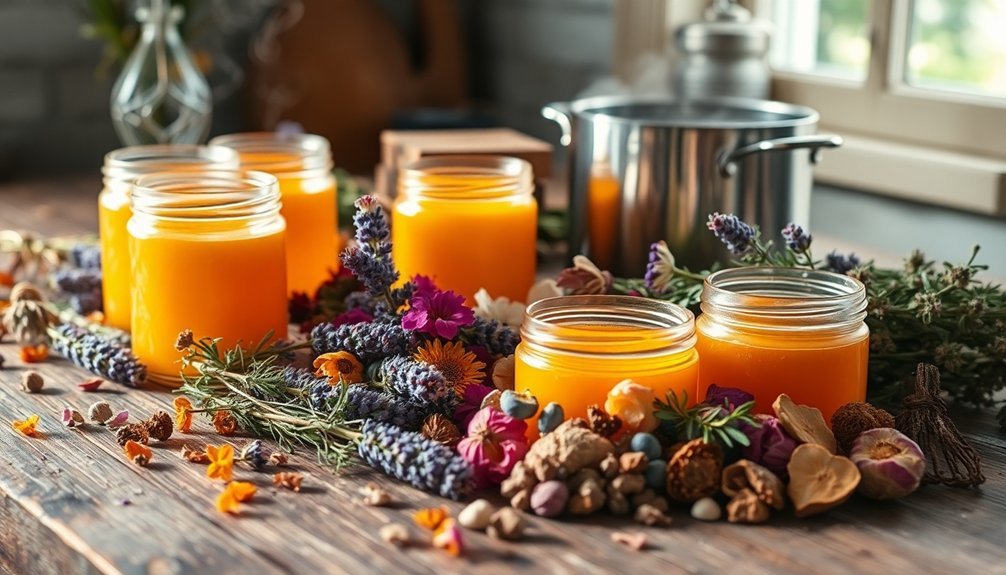
Plant-based waxes serve as the foundation for creating vegan solid perfumes, each offering unique properties that affect your final product.
When selecting your base wax, you'll need to take into account melting points, hardness, and stability to guarantee your perfume maintains its form and fragrance.
Key characteristics to take into account for your DIY perfume project:
- Carnauba wax provides excellent stability with its high melting point (80-85°C)
- Candelilla wax offers a firm texture and moderate melting point (68-73°C)
- Soy wax brings a softer consistency and lower melting point (49-52°C)
- Rice bran wax delivers a medium-hard texture ideal for portable perfumes
- All options are cruelty-free alternatives to traditional beeswax
You'll find that harder waxes like carnauba and candelilla work best for solid perfumes that need to withstand higher temperatures during daily use.
These natural waxes are composed of long-chain fatty acids and esters that provide protective properties while maintaining your fragrance blend.
Selecting Your Essential Oil Blends
The art of selecting essential oils demands careful consideration of how different scents interact and evolve over time. You'll want to understand the three key note types – top, middle, and base – to create a balanced fragrance that unfolds beautifully on your skin.
| Note Type | Common Scents | Characteristics |
|---|---|---|
| Top | Lemon, Bergamot | Quick to evaporate, fresh |
| Middle | Rose, Ylang-ylang | Body and character |
| Base | Sandalwood, Vanilla | Long-lasting, grounding |
Start with simple combinations and test them on blotting paper. You'll find that citrus oils provide an uplifting opening, while floral middle notes add depth, and woody base notes guarantee longevity. Consider the season and occasion – light florals work well in spring, while warm spices suit winter perfectly.
Measuring and Mixing Techniques
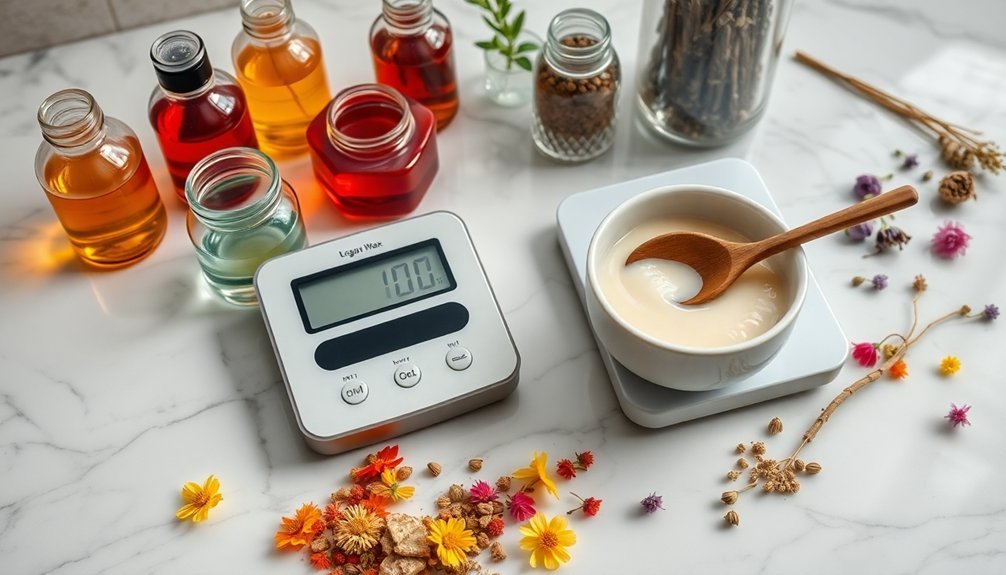
Creating successful vegan perfumes depends heavily on precise measurements and proper mixing techniques. You'll need to use a digital scale for accurate measurements and maintain specific ratios between your wax and fragrance oils.
When melting your wax, always use a double boiler method to prevent overheating and potential discoloration.
For the best results, follow these essential mixing steps:
- Zero your scale before each measurement
- Heat different waxes separately when blending
- Add fragrance oils slowly while stirring constantly
- Check for any oil separation as you mix
- Allow the mixture to cool completely in your chosen container
Remember to stir thoroughly as you combine your ingredients, ensuring everything is fully incorporated before pouring into your prepared containers.
This attention to detail will result in perfectly blended vegan perfumes.
The Art of Scent Layering
You'll discover that scent layering starts with mastering simple blending techniques, where natural fragrances can be combined to create unique personal signatures.
By understanding how top notes interact with middle and base notes, you can craft harmonious combinations that evolve beautifully throughout the day.
Whether you're working with essential oils or vegan wax bases, proper layering allows you to build complex aromas that reflect your individual style while maintaining the integrity of each component.
Simple Blending Techniques
Mastering simple blending techniques starts with understanding how different scent layers interact.
You'll want to begin by selecting essential oils that complement each other across the three note categories: top, middle, and base. Start with small test batches using blotting paper to guarantee your chosen scents work well together.
For successful blending, remember these key ratios and steps:
- Use 20-40 drops of essential oils per recipe
- Test stronger oils in smaller quantities first
- Allow 2 weeks for scent maturation
- Maintain a temperature of 40°C when adding oils
- Combine 9g of candelilla wax with 22g of carrier oil
Once you've mastered these basics, you can create unique combinations while guaranteeing no single scent overpowers the others.
Keep notes of successful blends for future reference.
Natural Fragrance Combinations
The art of scent layering builds upon basic blending skills to reveal enchanting fragrance combinations. You'll discover how to pair essential oils that complement or contrast each other, creating depth and character in your vegan wax perfumes. By exploring different fragrance families, you can craft unique seasonal variations that adapt to your body chemistry.
| Base Notes | Top Notes |
|---|---|
| Vanilla | Bergamot |
| Sandalwood | Lavender |
| Patchouli | Orange |
| Cedarwood | Peppermint |
Start with just a few drops of concentrated essential oils to achieve significant impact. Remember that natural oils offer the full spectrum of plant aromas, making them ideal for sustainable, personalized perfumery. As you experiment, record your successful combinations to replicate your signature scents. Each blend becomes an expression of your creativity and personal style.
Top-Middle-Base Note Harmony
Building a harmonious fragrance requires understanding the delicate interplay between top, middle, and base notes. When you're creating your vegan wax perfume, you'll need to balance these three layers carefully, following the ideal proportions of 20-40% top notes, 50-75% middle notes, and 5-10% base notes.
Your fragrance will unfold in stages:
- Top notes like lemon and bergamot create your first impression (5-15 minutes)
- Middle notes such as lavender and rose form the heart (20-60 minutes)
- Base notes including sandalwood and vanilla provide lasting power (6+ hours)
- Candelilla wax helps bind your layers together
- Proper blending guarantees a harmonious evolution
You'll notice how top notes quickly give way to the heart of your fragrance, while base notes anchor the entire composition for long-lasting wear.
Container Selection and Storage Tips
Successful vegan wax perfume making starts with choosing the right containers and knowing how to store them properly.
You'll want to select containers made from glass, metal, or BPA-free plastic to maintain your fragrance's integrity. Lip balm tubes and small tins are perfect for portability, while 1/2 oz jars work well for sampling different scents.
Store your perfumes in cool, dry places away from direct sunlight to prevent melting and preserve potency.
Use air-tight containers to keep your fragrance oils fresh and prevent oxidation. When handling your perfumes, always use clean hands and properly label your containers with fragrance names and ingredients.
Troubleshooting Common Texture Issues

When making vegan wax perfumes, you'll need to monitor the balance between waxes and oils closely to achieve the perfect consistency.
You can prevent surface cracks and brittleness by ensuring proper heating temperatures and allowing your mixture to cool gradually at room temperature.
If you're experiencing texture issues, try adjusting your ratios by incorporating more candelilla or carnauba wax for stability, or adding carrier oils for improved spreadability.
Achieving Perfect Consistency
Creating the perfect texture for vegan wax perfumes can sometimes feel like a delicate balancing act, but most common consistency issues have straightforward solutions.
When your perfume isn't quite right, you'll need to adjust the wax-to-oil ratio carefully.
Here's what you can do to fix common texture problems:
- Add more carrier oil if your perfume is too hard
- Increase wax content if the mixture is too soft or oily
- Mix thoroughly to prevent wax from floating to the top
- Use an emulsifying agent to prevent separation
- Allow several days for the perfume to mature and settle
Remember to heat your ingredients using a double boiler or carefully monitored microwave, and let the mixture cool to about 40°C before adding essential oils.
This careful temperature control will help guarantee your perfume maintains the perfect consistency.
Preventing Surface Cracks
Surface cracks can quickly derail your carefully crafted vegan wax perfumes, even when you've mastered the perfect consistency. To prevent these frustrating flaws, you'll need to focus on your cooling process and ingredient ratios.
Start by allowing your mixture to cool gradually at room temperature, avoiding any sudden temperature changes. When working with candelilla wax, pair it with jojoba oil to achieve the right pliability.
Don't overstir your mixture, as this introduces troublesome air bubbles that can lead to cracking.
You'll also want to prepare your containers by lightly coating them with oil to prevent adhesion. Space your containers apart during cooling, and store your finished perfumes in a cool, dry place to maintain their stability.
If cracks do appear, you can carefully use a heat gun to smooth the surface.
Extending Your Perfume's Shelf Life
To maximize the longevity of your handmade vegan wax perfumes, proper storage and handling play vital roles. Keep your creations in cool, dark places away from direct sunlight and heat sources to prevent degradation of essential oils and wax structures.
For ideal preservation, follow these key storage practices:
- Store perfumes in their original, airtight containers
- Keep them in a temperature-controlled environment
- Avoid humid areas like bathrooms
- Protect from UV exposure by using opaque containers
- Rotate your collection to use older perfumes first
The ingredients you choose also impact shelf life. Candelilla wax offers excellent durability, while jojoba oil helps maintain stability without compromising longevity.
Remember that higher fragrance concentrations typically last longer, but proper storage remains essential for maintaining your perfume's quality over time.
Customizing Scents for Different Seasons
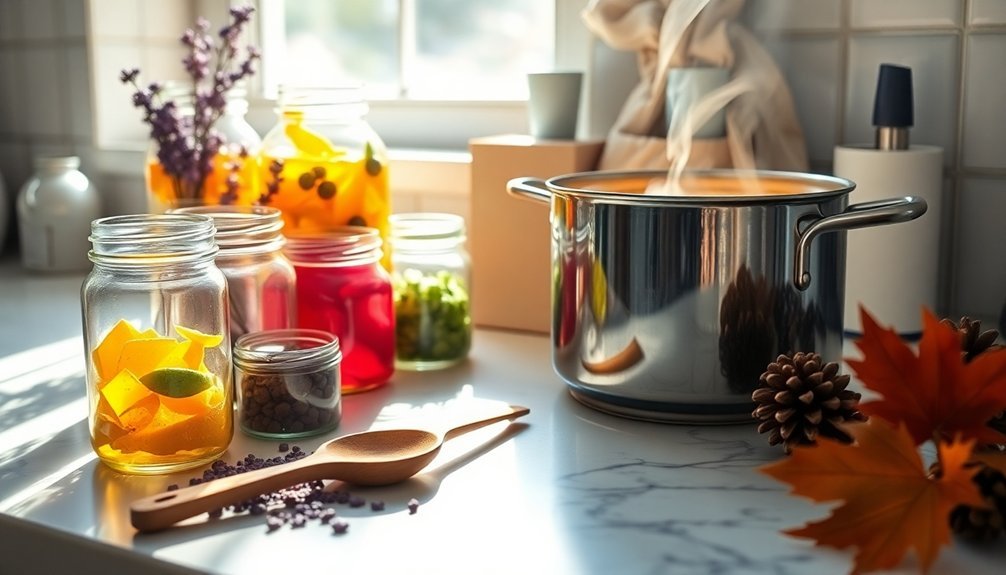
You'll find endless possibilities when creating seasonal perfumes, from light citrus-forward summer blends with sweet orange and palmarosa to rich winter combinations featuring cinnamon and vanilla.
Winter perfumes can incorporate warming notes like clove to create cozy, intimate fragrances that comfort during cold months.
For summer scents, you can mix uplifting essential oils like rose absolute with bright citrus notes to capture the essence of warm, sunny days.
Summer Fresh Blends
When summer arrives, creating fresh and vibrant perfume blends can capture the season's cheerful essence.
You'll find that tropical and fruity combinations work perfectly for the warm weather, offering light and invigorating scents that'll complement sunny days.
Consider these enticing summer blend options for your vegan wax perfumes:
- Tropical Fruits: A delightful mix of pineapple, mango, and coconut
- Coconut Lime Verbena: A zesty combination with a tropical twist
- Watermelon Lemonade: A cool, rejuvenating blend perfect for hot days
- Butt Naked: A fruity medley featuring melons and orchard fruits
- Hawaiian Blast: A vibrant mix of citrus, tropical fruits, and subtle floral notes
Experiment with these combinations in your candelilla wax base, adjusting the ratios until you've created your perfect summer signature scent.
Winter Warming Notes
As winter's chill settles in, warming fragrances can transform your vegan wax perfumes into cozy companions for the cold season.
You'll want to focus on rich, deep notes like cedarwood and sandalwood, which create that fireside ambiance you crave during frosty days.
For your winter blends, consider incorporating spicy accents like cinnamon and cardamom, paired with comforting amber and vanilla notes.
These combinations work particularly well in higher concentrations, ensuring your scent lasts through those heavy winter layers.
Don't forget to explore oriental and chypre families for complex, enduring fragrances.
If winter blues hit, add uplifting citrus or invigorating herbal notes to brighten your mood.
Using vegan ingredients like candelilla wax provides an ethical base that's gentle on your skin while carrying these warming scents beautifully.
Scaling Your Recipe for Batch Production
Scaling up your homemade vegan wax perfume recipe requires careful attention to measurements and proportions to maintain consistent quality.
You'll need precise tools like a reliable scale and proper heating equipment to guarantee each batch meets your standards.
When increasing your production volume, remember these essential steps:
- Use a double boiler or bain-marie to prevent wax from overheating
- Maintain exact ratios of carrier oils to wax across all batch sizes
- Test fragrance blends on blotting paper before adding to melted wax
- Document measurements meticulously for future reference
- Allow each batch to mature for two weeks before use
Keep your workspace clean and organized while scaling up production.
You'll find that investing in proper equipment and following consistent procedures helps maintain the quality of your vegan perfumes, regardless of batch size.
Creative Packaging Ideas for Gifting
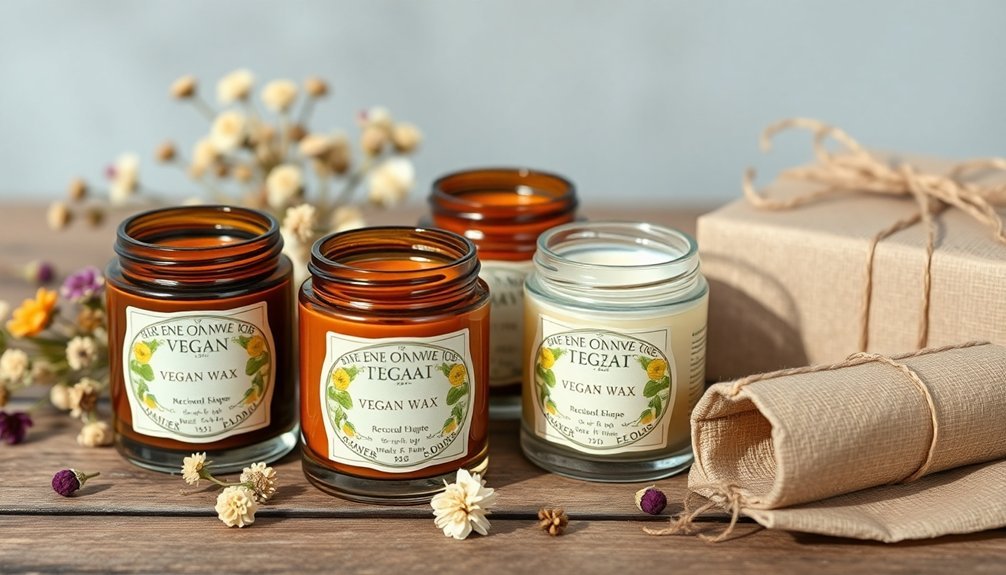
Now that you've mastered batch production, let's explore the artistry of packaging your vegan wax perfumes for gifting.
Opt for sustainable containers like recyclable tins or small glass jars that recipients can reuse. Create a visually appealing presentation by incorporating nature-inspired designs and colors that match your perfume's ingredients.
Make your gifts stand out by using handwritten labels and natural ribbons made from cotton or jute.
You'll want to take into account offering customizable gift sets that include multiple scents or complementary products. For travel-friendly options, package your perfumes in portable roll-on bottles or small tins, protected by cloth pouches.
Don't forget to include a handmade card detailing the ingredients and care instructions. These thoughtful touches will make your homemade perfumes even more special as gifts.
Frequently Asked Questions
Can I Make Vegan Wax Perfumes if I Have Sensitive Skin?
Yes, you can make vegan wax perfumes for sensitive skin. Choose gentle ingredients like candelilla wax and hypoallergenic oils, and always do a patch test before applying. You'll have control over all ingredients.
How Much Money Can I Save Making Vegan Perfumes Versus Buying Them?
You'll save roughly 40-60% per ounce making vegan perfumes at home. With bulk ingredients and no brand markup, your $50 store-bought perfume could cost about $20-30 to make yourself.
Are Vegan Wax Perfumes Safe to Use During Pregnancy?
While vegan wax perfumes can be safer than conventional ones, you'll need to carefully select your essential oils since some aren't pregnancy-safe. Always consult your healthcare provider before using any new fragrances during pregnancy.
Will Vegan Wax Perfumes Stain My Clothes or Jewelry?
You'll find vegan wax perfumes are generally safe for clothes due to their natural ingredients. However, you should avoid direct contact with jewelry, as they can still cause discoloration or tarnishing on metal surfaces.
Can I Sell My Homemade Vegan Wax Perfumes Legally?
Yes, you can sell your homemade vegan wax perfumes legally, but you'll need to obtain proper cosmetics safety assessments, comply with local regulations, guarantee correct ingredient labeling, and maintain appropriate insurance coverage.

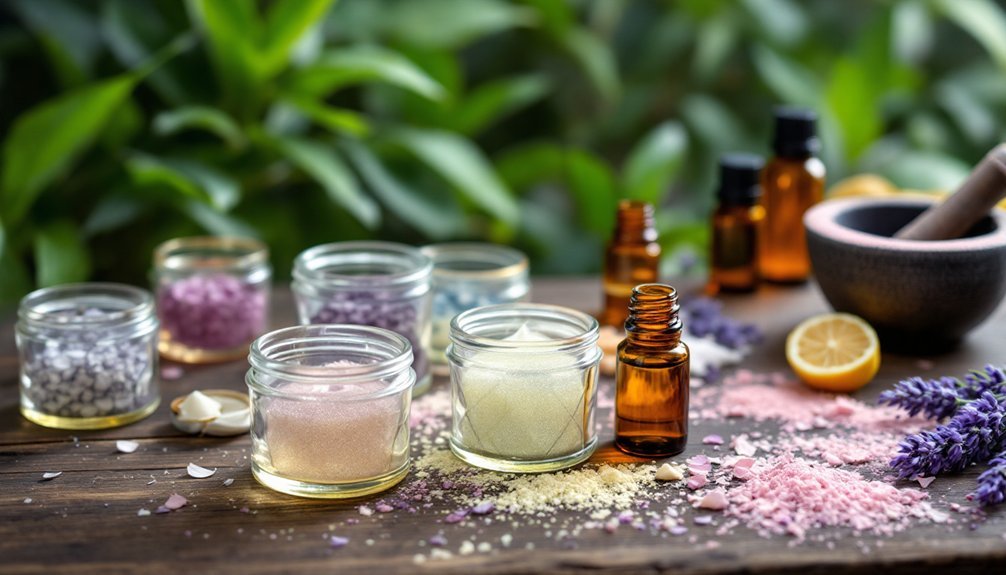



Leave a Reply